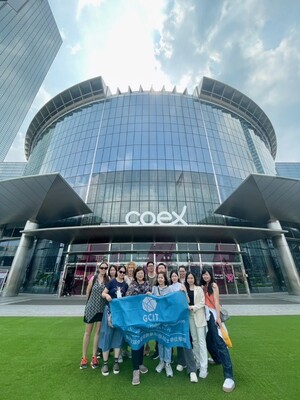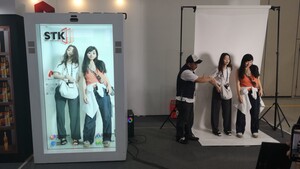Date :
2023-07-17
Department :
Master’s Program in Global Communication and Innovation Technology
【Article by the Master's Program in Global Communication and Innovation Technology】
The Master's Program in Global Communication and Innovation Technology (GCIT) overseas learning group, led by Program Director Mei-Ling Hsu, Visiting Professor Christine Cook, with the participation of nine students and one office assistant, embarked on a fulfilling and comprehensive journey to South Korea from June 20 to 30. During the 11-day trip, the group had the opportunity to visit various high-tech and cultural destinations.
Among the notable visits were Pearl Abyss, a game development company, the e-sports stadium LOL Park, Korean TV stations KBS and SBS, YouTuber DKDKTV, and other media organizations. Additionally, the group explored VR Zone, Leeum Museum (Samsung Museum of Art), and Dongdaemun Design Plaza and attended the "Smart Tech Korea (STK) 2023" exhibition, which showcased the latest advancements in AI technology. They also enjoyed a performance of "The Painters Show," a unique blend of art, drama, music, and new media technology. The GCIT group visited the National Museum of Korea, Gyeongbokgung Palace, Cheong Wa Dae (the Presidential Blue House), and other historical and cultural sites to delve into Korea's rich heritage. Through these experiences, the students gained valuable insights into Korean new media technology, the "Korean Wave" (Korean popular culture), and cultural content development, inspiring reflections on Taiwan's own "soft power."
One of the highlights of the South Korea visit was the group's attendance at the "Smart Tech Korea (STK) 2023" exhibition. Organized by the South Korean Ministry of Trade, Industry, and Energy in collaboration with industry associations and technology companies, the exhibition showcased the latest product applications and technological solutions. Visitors could witness cutting-edge technologies such as Augmented Reality (AR) cosmetic makeup technology, automated tennis ball dispensers, 3D precision rotating scanners with AI analysis, Non-Fungible Tokens (NFT), and real-time 3D cartoon photography software.
GCIT student Jessica Archendy from Indonesia expressed her fascination: “We had the chance to witness cutting-edge technologies not yet available on our campus. It was truly captivating to see these innovations first-hand. Additionally, we had the opportunity to actively participate in engaging product demonstrations and gain knowledge about the workings of the latest technologies." Another GCIT student Elizabeth Milenova, also from Indonesia, further elaborated on the four emerging technology exhibits, highlighting their impressive combination of new technologies into innovative software/business models.
The GCIT group also enjoyed immersive VR experiences at VR Zone in I-Park Mall Yongsan Mall. The VR Zone offered a range of games, including immersive roller coasters, multiplayer car racing, interactive spaceship hydraulic simulators, and zombie shooting in designated rooms. Comparing the VR gaming environments in South Korea and Taiwan, GCIT student Kuei-Han Wang from Taiwan noted that while VR game facilities in Taiwan often require significant expenses or visits to specific locations, South Korean shopping malls offer VR gaming experiences at competitive prices. Wang expressed excitement over the thrilling shooting games and their enhanced immersive experience.
Another memorable visit was to Leeum Museum, supported by the technology conglomerate Samsung Corporation. The museum showcased Korean artifacts and relics from different dynasties and incorporated immersive VR technology. Visitors were provided with VR headsets to experience interactive learning about Korean culture and heritage. During an exhibition of the multi-media artist Hayoun Kwon's (權河允) work "Strange Walkers," the GCIT group had the opportunity to revisit the 18th-century Korean masterpiece "Taoist Immortals" by Gim Hong-do (金弘道). The VR experience allowed visitors to follow the path of the immortal gods and encounter other eternal walkers, such as refugees on the road to exodus or stars in the firmament. Through these parallel representations, visitors traveled through different scenes, moving forward and backward in time alongside the eternal walkers (See https://shorturl.at/arv36 for details).





